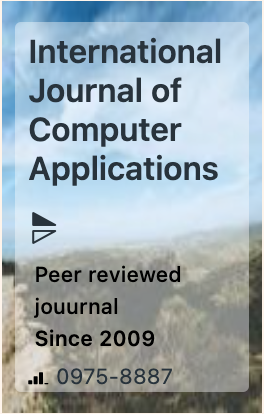The week's pick
Random Articles
Reseach Article
Spatial Heterogeneity Modeling of the Neighborhood Effects and Socio-economic Factors on Burglary Crimes in Nigeria
| International Journal of Computer Applications |
| Foundation of Computer Science (FCS), NY, USA |
| Volume 186 - Number 60 |
| Year of Publication: 2025 |
| Authors: Rasheed A. Adeyemi, Jamiu S. Olumoh, Aminu Ibrahim |
 10.5120/ijca2025924204
10.5120/ijca2025924204
|
Rasheed A. Adeyemi, Jamiu S. Olumoh, Aminu Ibrahim . Spatial Heterogeneity Modeling of the Neighborhood Effects and Socio-economic Factors on Burglary Crimes in Nigeria. International Journal of Computer Applications. 186, 60 ( Jan 2025), 1-11. DOI=10.5120/ijca2025924204
Abstract
This paper examined the geographical patterns of distribution in burglary crimes (residential and nonresidential) in Nigeria for the incidence year 2017. The study used a novel approach that integrates spatial structures into the traditional regression framework and evaluates the spatial disparities in neighborhood effects and the socio-economic characteristics of burglary crimes at sub-national levels. The study proposed four spatially varying models to demonstrate the importance of incorporating spatial dependence components in the models. The determinant factors included in the model are; unemployment, education, and poverty indices, alongside demographic variables, to understand crime patterns. The determinant factors included in the model are; the unemployment rate, education index, population density, percent economic deprivation, multidimensional poverty index (MPI), and proportion of young adult males resident in the state. A Bayesian analysis was performed via Markov chain Monte Carlo simulations to estimate the model parameters. The analysis revealed that the proportional contribution due to the neighborhood (clustering) effect was estimated as 24.7% for the house-breaking and the estimated neighborhood contribution as 29.0% for the store-breaking occurrence. This approach demonstrates superiority in model performance, as indicated by the lowest Deviance Information Criterion (DIC). Findings reveal negative associations between burglary and multidimensional poverty, while young male adults show a positive relationship with storebreaking incidents. Hot spot areas and spatial variations in crime patterns are identified, offering insights for criminologists and informing policing strategies for effective crime prevention.
References
- Rasheed A. Adeyemi, James Mayaki, Temesgen T. Zewotir, and Shaun Ramroop. Demography and crime: A spatial analysis of geographical patterns and risk factors of crimes in nigeria. Spatial Statistics, 41:100485, 2021.
- Michael Oloyede Alabi and Eleojo O Abubakar. Sustainable urban form: socio-demographic and permeability factors as determinants of crime spots in cities, case of akure, nigeria. Urban, Planning and Transport Research, 11(1):2195469, 2023.
- Sabina Alkire, Usha Kanagaratnam, and Nicolai Suppa. The global multidimensional poverty index (MPI) 2021, OPHI, MPI Methodological Notes 51. Oxford Poverty and Human Development Initiative (OPHI), 2021.
- Martin A Andresen and Nicolas Malleson. Spatial heterogeneity in crime analysis. Crime modeling and mapping using geospatial technologies, pages 3–23, 2013.
- Julian Besag, Jeremy York, and Annie Molli´e. Bayesian image restoration, with two applications in spatial statistics. Annals of the institute of statistical mathematics, 43(1):1–20, 1991.
- Nicky Best and Anna Louise Hansell. Geographic variations in risk: adjusting for unmeasured confounders through joint modeling of multiple diseases. Epidemiology (Cambridge, Mass.), 20(3):400, 2009.
- Nicky Best, Sylvia Richardson, and Andrew Thomson. A comparison of bayesian spatial models for disease mapping. Statistical methods in medical research, 14(1):35–59, 2005.
- Pere Boqu´e, Marc Saez, and Laura Serra. Need to go further: using inla to discover limits and chances of burglaries spatiotemporal prediction in heterogeneous environments. Crime Science, 11(1):1–22, 2022.
- A Braga, A Papachristos, and D Hureau. Hot spots policing effects on crime. Campbell Systematic Reviews, 8:94, 2012.
- Patricia Brantingham and Paul Brantingham. Criminality of place: Crime generators and crime attractors. Eur. J. on Crim. Pol’y & Rsch., 3:5, 1995.
- Paul Brantingham and Patricia Brantingham. Crime pattern theory. In Environmental criminology and crime analysis, pages 100–116. Willan, 2013.
- Spencer P Chainey. Examining the influence of cell size and bandwidth size on kernel density estimation crime hotspot maps for predicting spatial patterns of crime. Bulletin of the Geographical Society of Liege, 60:7–19, 2013.
- Jarvis T Chen. 11 multilevel and hierarchical models for disease mapping. Geographic health data: fundamental techniques for analysis, page 183, 2013.
- David Clayton and John Kaldor. Empirical bayes estimates of age-standardized relative risks for use in disease mapping. Biometrics, pages 671–681, 1987.
- David G Clayton. Generalized linear mixed models. Markov chain Monte Carlo in practice, 1:275–302, 1996.
- Sam J Cole. Social and physical neighbourhood effects and crime: Bringing domains together through collective efficacy theory. Social Sciences, 8(5):147, 2019.
- C Eck and J Eck. Becoming a problem-solving crime analyst in 55 small steps, 2003.
- Karen Frenken. Irrigation in Africa in figures: AQUASTAT Survey, 2005, volume 29. Food & Agriculture Org., 2005.
- Andrew Gelman, John B Carlin, Hal S Stern, and Donald B Rubin. Bayesian data analysis. chapman & hall/crc. Inc., New York, 2004.
- Zubairu Abubakar Ghani. A comparative study of urban crime between malaysia and nigeria. Journal of Urban Management, 6(1):19–29, 2017.
- WR Gilks, S Richardson, and DJ Spiegelhalter. Markov chain monte carlo in practice chapman & hall: London. Markov Chain Monte Carlo in practice. Chapman and Hall, London., 1996.
- Harvey Goldstein. Consistent estimators for multilevel generalised linear models using an iterated bootstrap. Multilevel Modelling Newsletter, 8(1):3–6, 1996.
- Enrique Gracia, Antonio L´opez-Qu´ılez, Miriam Marco, Silvia Lladosa, and Marisol Lila. Exploring neighborhood influences on small-area variations in intimate partner violence risk: A bayesian random-effects modeling approach. International journal of environmental research and public health, 11(1):866–882, 2014.
- Susanne Gschl¨oßl and Claudia Czado. Modelling count data with overdispersion and spatial effects. Statistical papers, 49:531–552, 2008.
- Idris Isah Iliyasu, Aldrin Abdullah, and Massoomeh Hedayati Marzbali. Spatial pattern of burglary in residential neighbourhoods: a case study of abuja, nigeria. Journal of Facilities Management, 2022.
- Joanna Jacob. Male and female youth crime in canadian communities: Assessing the applicability of social disorganization theory. Canadian Journal of Criminology and Criminal Justice, 48(1):31–60, 2006.
- Shane D Johnson and Kate J Bowers. The stability of spacetime clusters of burglary. British Journal of Criminology, 44(1):55–65, 2004.
- Shane D Johnson and Kate J Bowers. Permeability and burglary risk: Are cul-de-sacs safer? Journal of Quantitative Criminology, 26:89–111, 2010.
- Jane Law and Matthew Quick. Exploring links between juvenile offenders and social disorganization at a large map scale: A bayesian spatial modeling approach. Journal of Geographical Systems, 15:89–113, 2013.
- Jane Law, Matthew Quick, and Ping Chan. Bayesian spatiotemporal modeling for analysing local patterns of crime over time at the small-area level. Journal of quantitative criminology, 30(1):57–78, 2014.
- Andrew B Lawson. Bayesian disease mapping: hierarchical modeling in spatial epidemiology. CRC press, 2013.
- Andrew B Lawson, William J Browne, and Carmen L Vidal Rodeiro. Disease mapping with WinBUGS and MLwiN, volume 11. John Wiley & Sons, 2003.
- Duncan Lee. A comparison of conditional autoregressive models used in bayesian disease mapping. Spatial and spatiotemporal epidemiology, 2(2):79–89, 2011.
- Hongqiang Liu and Xinyan Zhu. Joint modeling of multiple crimes: A bayesian spatial approach. ISPRS International Journal of Geo-Information, 6(1):16, 2017.
- Maria Mahfoud, Wim Bernasco, Sandjai Bhulai, and Rob van der Mei. Forecasting spatio-temporal variation in residential burglary with the integrated laplace approximation framework: Effects of crime generators, street networks, and prior crimes. Journal of Quantitative Criminology, 37:835– 862, 2021.
- Mabel Morales-Otero and Vicente N´u˜nez-Ant´on. Comparing bayesian spatial conditional overdispersion and the besag– york–molli´e models: application to infant mortality rates. Mathematics, 9(3):282, 2021.
- Anwar Musah, Faisal Umar, Khadijat N Yakubu, Muktar Ahmad, Abdullah Babagana, Adamu Ahmed, Tatiana A Thieme, and James A Cheshire. Assessing the impacts of various street-level characteristics on the burden of urban burglary in kaduna, nigeria. Applied Geography, 114:102126, 2020.
- National Bureau of Statistics. Crimestatistics: Reported offences by type and states. Data can be downloaded at: www.nigerianstat.gov.ng, 2017.
- Jan Povala, Seppo Virtanen, and Mark Girolami. Burglary in london: insights from statistical heterogeneous spatial point processes. Journal of the Royal Statistical Society Series C: Applied Statistics, 69(5):1067–1090, 2020.
- Rafael G Ramos and Silas N Melo. Income inequality and the geography of residential burglaries: A spatial model applied to campinas, brazil. Applied Geography, 147:102787, 2022.
- Jerry H Ratcliffe. Aoristic signatures and the spatio-temporal analysis of high volume crime patterns. Journal of quantitative criminology, 18:23–43, 2002.
- Gabriel Rosser, Toby Davies, Kate J Bowers, Shane D Johnson, and Tao Cheng. Predictive crime mapping: Arbitrary grids or street networks? Journal of quantitative criminology, 33:569–594, 2017.
- Jen-Li Shen and Martin A Andresen. A tale of two theories: Whither social disorganization theory and the routine activities approach? Canadian Journal of Criminology and Criminal Justice, 63(2):1–22, 2021.
- Corey S Sparks. Violent crime in san antonio, texas: An application of spatial epidemiological methods. Spatial and spatiotemporal epidemiology, 2(4):301–309, 2011.
- David J Spiegelhalter, Nicola G Best, Bradley P Carlin, and Angelika Van Der Linde. Bayesian measures of model complexity and fit. Journal of the Royal Statistical Society: Series B (Statistical Methodology), 64(4):583–639, 2002.
- David J Spiegelhalter, Andrew Thomas, Nicky G Best, Wally Gilks, and D Lunn. Bugs: Bayesian inference using gibbs sampling. Version 0.5,(version ii) http://www. mrc-bsu. cam. ac. uk/bugs, 19, 1996.
- Andrew Thomas, Nicky Best, Dave Lunn, Richard Arnold, and David Spiegelhalter. Geobugs user manual. Cambridge: Medical Research Council Biostatistics Unit, 2004.
- Andromachi Tseloni. Personal criminal victimization in the united states: Fixed and random effects of individual and household characteristics. Journal of Quantitative Criminology, 16(4):415–442, 2000.
- JC Wakefield, NG Best, and L Waller. Bayesian approaches to disease mapping. Spatial epidemiology: methods and applications, pages 104–107, 2000.
- Zengli Wang and Xuejun Liu. Analysis of burglary hot spots and near-repeat victimization in a large chinese city. ISPRS International Journal of Geo-Information, 6(5):148, 2017.
Index Terms
Keywords

